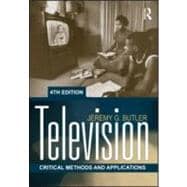
Note: Supplemental materials are not guaranteed with Rental or Used book purchases.
Purchase Benefits
What is included with this book?
| Preface | p. xi |
| Acknowledgments | p. xvii |
| Television Structures and Systems | p. 1 |
| An Introduction to Television Structures and Systems: Ebb and Flow in the Postnetwork Era | p. 3 |
| Television's Not-So-Distant Past: The Network Era | p. 4 |
| Polysemy, Heterogeneity, Contradiction | p. 6 |
| Interruption and Sequence | p. 12 |
| Segmentation | p. 13 |
| Halting the Flow: Television in the Postnetwork Era | p. 13 |
| Summary | p. 17 |
| Further Readings | p. 18 |
| Narrative Structure: Television Stories | p. 21 |
| The Theatrical Film | p. 22 |
| The Television Series | p. 33 |
| The Television Serial | p. 41 |
| Transmedia Storytelling | p. 48 |
| Summary | p. 51 |
| Further Readings | p. 51 |
| Building Narrative: Character, Actor, Star | p. 55 |
| Building Characters | p. 57 |
| Building Performances | p. 65 |
| The Star System? | p. 80 |
| Summary | p. 92 |
| Further Readings | p. 92 |
| Beyond and Beside Narrative Structure | p. 97 |
| Television's Reality | p. 98 |
| Television's Reality: Forms and Modes | p. 101 |
| Television's Reality: Genres | p. 113 |
| Summary | p. 142 |
| Further Readings | p. 142 |
| . The Television Commercial | p. 149 |
| U.S. TV's Economic Structure | p. 150 |
| The Polysemy of Commodities | p. 159 |
| The Persuasive Style of Commercials | p. 176 |
| Summary: "Capitalism in Action" | p. 204 |
| Further Readings | p. 205 |
| Television Style: Image and Sound | p. 209 |
| An Introduction to Television Style: Modes of Production | p. 211 |
| Single-Camera Mode of Production | p. 213 |
| Multiple-Camera Mode of Production | p. 218 |
| Hybrid Modes of Production | p. 222 |
| Summary | p. 224 |
| Further Readings | p. 224 |
| Style and Setting: Mise-en-Scene | p. 227 |
| Set Design | p. 227 |
| Costume Design | p. 240 |
| Lighting Design | p. 240 |
| Actor Movement | p. 248 |
| Summary | p. 249 |
| Further Readings | p. 250 |
| Style and the Camera: Videography and Cinematography | p. 253 |
| Basic Optics: The Camera Lens | p. 254 |
| Image Definition and Resolution | p. 261 |
| Color and Black-and-White | p. 269 |
| Framing | p. 270 |
| In-Camera Visual Effects | p. 288 |
| Summary | p. 290 |
| Further Readings | p. 291 |
| Style and Editing | p. 293 |
| The Single-Camera Mode of Production | p. 293 |
| The Multiple-Camera Mode of Production | p. 314 |
| Continuity Editing and Hybrid Modes of Production | p. 319 |
| Summary | p. 321 |
| Further Readings | p. 322 |
| Style and Sound | p. 325 |
| Types of Television Sound | p. 326 |
| Purposes of Sound on Television | p. 335 |
| Acoustic Properties and Sound Technology | p. 341 |
| Space, Time, and Narrative | p. 350 |
| Summary | p. 353 |
| Further Readings | p. 354 |
| Television Studies | p. 357 |
| An Introduction to Television Studies | p. 359 |
| Critical Research and Television | p. 360 |
| Further Readings | p. 363 |
| Textual Analysis | p. 367 |
| Television Authorship | p. 367 |
| Style and Stylistics | p. 370 |
| Genre Study | p. 375 |
| Semiotics | p. 381 |
| Summary | p. 390 |
| Further Readings | p. 391 |
| Discourse and Identity | p. 395 |
| Ideological Criticism and Cultural Studies | p. 395 |
| The Discourse of the Industry I: Production Studies | p. 403 |
| The Discourse of the Industry II: Political Economy | p. 406 |
| Discourse and Identity I: Gender | p. 410 |
| Discourse and Identity II: Queer Theory | p. 416 |
| Discourse and Identity III: Race and Ethnicity | p. 418 |
| Summary | p. 421 |
| Further Readings | p. 422 |
| Sample Analyses and Exercises | p. 429 |
| Mass Communication Research | p. 435 |
| Glossary | p. 445 |
| Index | p. 473 |
| Table of Contents provided by Ingram. All Rights Reserved. |
The New copy of this book will include any supplemental materials advertised. Please check the title of the book to determine if it should include any access cards, study guides, lab manuals, CDs, etc.
The Used, Rental and eBook copies of this book are not guaranteed to include any supplemental materials. Typically, only the book itself is included. This is true even if the title states it includes any access cards, study guides, lab manuals, CDs, etc.